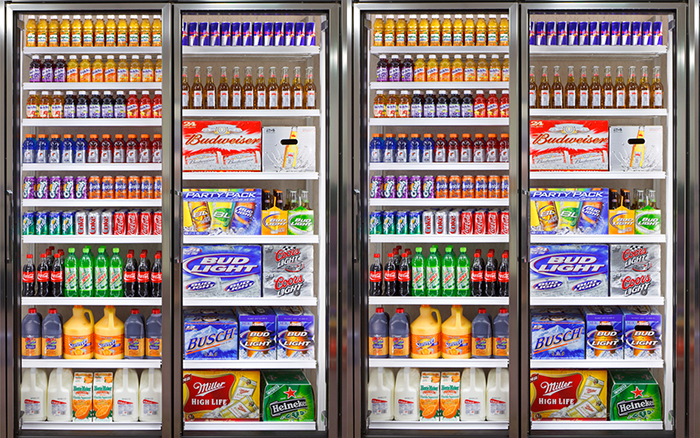Top-Mount vs Side-Mount Units
When selecting a refrigeration unit, businesses often weigh the benefits of top-mount versus side-mount systems. Each type has distinct advantages depending on the cooler’s design, space constraints, and operational needs.
Top-Mount Units
Placed on top of the walk-in cooler, top-mount units are a popular option for businesses aiming to save space within the cooler itself. Here’s what you need to know:
Advantages
- Space Efficiency: Top-mount units don’t take up valuable storage space inside the cooler, leaving more room for products.
- Better Protection: Positioned above the cooler, these units are less exposed to dust, debris, and accidental damage.
- Improved Air Circulation: Top-mounted configurations allow cold air to flow downward naturally, achieving even cooling throughout the space.
Drawbacks
- Ceiling Height Requirements: These units may not be suitable for locations with low ceilings.
- Maintenance Accessibility: Servicing the unit can be challenging as technicians may need ladders or lifts to reach it.
Side-Mount Units
Installed on the side wall of the walk-in cooler, side-mount units are an excellent choice for specific layouts or spaces with height restrictions.
Advantages
- Easier Access for Maintenance: Positioned at eye level, side-mount units are convenient for routine servicing and repairs.
- Versatile Placement: A good option when there isn’t sufficient vertical room to accommodate a top-mounted unit.
- Cost-Effective: Side-mounted units are often more affordable both in terms of purchase and maintenance costs.
Drawbacks
- Reduced Storage Space: They occupy wall space within the cooler, potentially limiting shelving or storage capacity.
- Lower Cooling Uniformity: May require additional internal airflow controls to ensure even temperature distribution.
Which Is Better?
The choice between top-mount and side-mount units depends on factors like available space, how the cooler is used, and the ease of maintenance required for your business operations. Carefully evaluate your setup before making a decision.
Brands and Models
Selecting the right refrigeration unit often comes down to choosing a trusted brand that offers proven performance and reliability. Here are some of the top brands and models we offer, each designed to meet a range of commercial and industrial cooling needs.
Trusted Brands
- Copeland
Copeland stands out for its energy-efficient and durable refrigeration units. Incorporating advanced compressor technologies, their units reduce energy consumption while ensuring minimal downtime.
- Heatcraft
Known for their innovative solutions, Heatcraft units offer industry-leading temperature control and compatibility with various cooler designs. Many models also feature advanced defrost systems to prevent ice build-up.
- Bohn
Bohn refrigeration units are ideal for both commercial and industrial applications, offering robust construction and unparalleled reliability. Their models often include intuitive controls for ease of operation.
Highlighted Features
- Eco-Friendly Options
Many brands now offer refrigeration units with eco-friendly refrigerants like R-290 propane, reducing environmental impact while meeting performance standards.
- Smart Controllers
Integration with digital controllers allows for real-time monitoring and precise temperature adjustments.
- Energy Efficiency
Features like variable-speed compressors and adaptive defrost cycles ensure maximum efficiency and lower utility costs.
Regardless of your cooler’s size or application, these brands bring top-notch performance and durability to your refrigeration setup.
Sizing Guide
Choosing the right refrigeration unit isn’t just about picking a reputable brand—it also comes down to selecting a model that matches your walk-in cooler’s dimensions and intended usage. An undersized unit may struggle to maintain temperatures, while an oversized unit could lead to unnecessary energy costs.
Calculating Cooler Volume
Begin by calculating the volume of your walk-in cooler in cubic feet:
Length x Width x Height = Volume in Cubic Feet
This measurement will serve as the foundation for determining the appropriate refrigeration capacity.
Key Considerations
1. Usage Frequency:
Coolers that are frequently accessed, such as those in busy kitchens or grocery stores, require units with higher cooling capacities to recover lost cold air.
2. Ambient Temperature:
Consider the external temperature of the location where the cooler operates. Units installed in hot or unregulated environments may need more power to maintain consistent temperatures.
3. Product Type:
Highly perishable items like raw meats or pharmaceuticals demand precise temperature control, often requiring units with advanced features for accuracy.
BTU (British Thermal Unit) Requirements
Refrigeration unit capacities are often measured in BTUs, indicating the amount of heat a unit can remove in one hour. Here’s a quick guide to calculating your approximate BTU requirement:
- General Rule of Thumb: 56 BTUs per cubic foot of cooler space for walk-ins maintaining temperatures around 38°F.
- Freezer Rule: 70 BTUs per cubic foot for freezers operating below 32°F.
For example, a 500-cubic-foot walk-in cooler used for general food storage would need approximately 28,000 BTUs (500 x 56) to keep items at the appropriate temperature.
Tip: Always consult with professionals to verify the BTU requirements based on your unique setup and cooling needs.
Ensuring Compatibility
When selecting a refrigeration unit, make sure it’s compatible with your walk-in cooler’s existing infrastructure, including:
- Voltage and Electrical Configuration: Confirm that your facility’s electrical system can support the unit’s power requirements.
- Insulation Quality: Pair your refrigeration unit with high-quality insulation to prevent energy loss and ensure consistent performance.
- Ease of Integration: Modular coolers may allow for easier integration of units, while custom-built options might require specialized systems.

Contact Us for Expert Guidance
Choosing the right refrigeration unit is a crucial decision that impacts the performance and efficiency of your walk-in cooler. If you’re unsure about which system is best for your needs, our team is here to help. We offer personalized recommendations, professional advice, and tailored solutions to ensure your refrigeration system meets your business’s demands.
Reach out to us today to request a quote or schedule a consultation. Don’t leave the heart of your walk-in cooler to chance—partner with us for expert assistance and reliable performance!
Quick Contact Form

9310 OK-1 S, Ravia, OK 73455
877-843-0183
sales@jaycompdevelopment.com

